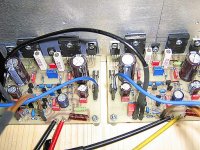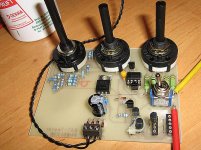MikeB said:
Sheldon, wow, that's gonna be some PSU !10.000uF each cap or even more ?
What are these brown battery-like things in the top corners ?
"One of two", are you building two stereos ?
Mike
8mf per cap. The brown things are 10uf Russian paper caps, used for input. I'm making two of these stereo amps. My speakers will have 8 channels total amplification, tweeter, mids, woofer, subs. I'll use the Syms on the woofer and subs. I have my original pair that I can also use on tweet and mids with passive speaker level crossover between t&m.
Sheldon
MikeB said:If you use it for subs and woofer, couldn't you use simple 22uf elyts ? I guess hf-quality should not matter in this case ?
Mike
True, but I already have the caps and I like to have the amps set up for full range frequency response and quality, if possible. I may employ them full range at some point and it doesn't cost much more to set them up that way from the get go. If I need more low end extension, I'd sub in or add some lytics in parallel.
I'm planning to use some low powered 801a SE tube amps for the tweeters and mids on the horn (110db or so efficiency) for moderate listening levels. For higher SPL, I'll use more power on the horns (maybe Symasym). The SE amps will actually won't be quite full range as they will roll off at around 20hz or so, as they will only power the horn down to about 350Hz. I could also set the -3db point on those at 3 or so Hz, but I'm already space limited for that chassis and I don't think it makes much sense to have a flea powered amp driving the bass registers at all.
These are the speakers: http://www.diyaudio.com/forums/showthread.php?s=&threadid=69906&highlight=
Sheldon
Hi to all,
the second channel is finnished since one week or so. The sound has improved comparing to my old Denon PMA amplifier. The bass is more precise, and drums show a more detailed sound now, so for me, this amp is definetly a keeper.
At a glance, the overall performance of my system is limited by the speakers and the CD player, which are far from top-of-the line devices.
Next I will remove the 100nF over the elyt of the feedback network, because I used a Panasonic FC type for the elyt.
I also like to design a DC protection circuit, before I put the amp into a case.
At the next weekes, there will be another 5.3 come to life, build by a friend of mine. He is living just around the corner as well.
We have designed a small BJT-Tester suited for power devices as well, I can post it if someone is interested.
the second channel is finnished since one week or so. The sound has improved comparing to my old Denon PMA amplifier. The bass is more precise, and drums show a more detailed sound now, so for me, this amp is definetly a keeper.
At a glance, the overall performance of my system is limited by the speakers and the CD player, which are far from top-of-the line devices.
Next I will remove the 100nF over the elyt of the feedback network, because I used a Panasonic FC type for the elyt.
I also like to design a DC protection circuit, before I put the amp into a case.
At the next weekes, there will be another 5.3 come to life, build by a friend of mine. He is living just around the corner as well.
We have designed a small BJT-Tester suited for power devices as well, I can post it if someone is interested.
Attachments
Hi Sheldon, you're right, if you have these caps anyway it's a good idea to keep the amps fullrange. That keeps it simple to experiment with different setups.
Your speakers look quite exotic ! Funny idea to use the same wood for passive radiator.
Tobi, nice to hear that you are pleased ! You're right, if the elyts are high quality you can remove the 100nF bypass caps. In my earlier version i used less quality elyts here, and the 100nF removed the colorized sound at once. A DC-protection can reduce quality if you get a relay into the output, but it gives a better feeling to know that the speakers are protected. The best protection might have the DC-protection shutting down the powersupply ?
One small question, looking at the orientation of the transistors in the inputstage, did you use bc550c in the input and 2n5551 for the ccs ? That's a combination i have not tried yet...
What do you think about mid and high range of symasym ?
Mike
Your speakers look quite exotic ! Funny idea to use the same wood for passive radiator.
Tobi, nice to hear that you are pleased ! You're right, if the elyts are high quality you can remove the 100nF bypass caps. In my earlier version i used less quality elyts here, and the 100nF removed the colorized sound at once. A DC-protection can reduce quality if you get a relay into the output, but it gives a better feeling to know that the speakers are protected. The best protection might have the DC-protection shutting down the powersupply ?
One small question, looking at the orientation of the transistors in the inputstage, did you use bc550c in the input and 2n5551 for the ccs ? That's a combination i have not tried yet...
What do you think about mid and high range of symasym ?
Mike
MikeB said:Funny idea to use the same wood for passive radiator.Mike
Had the cut outs, so might as well use them.
Sheldon
Mike: Yes, I used BC550 for the input stage and 2N5551 instead of the BC546 for the current sink.
About DC-protection: I thought of shortening the supply lines, too. But now I am considering about using a relay, because if you shorten the PSU lines via a SCR or similar, you may get into trouble during power-up. It has to be ensured, that the protection circuit does not fire the SCR's when you switch on the amp. This could be done by a short delay, but during this delay, the output is connected to the speaker. att'n:
A relay is normally open during turn-on, and it is much more easy to deal with.
I am no HiFi-guru, but I cannot imagine that one can hear the influence of a good relay between speaker and amp.
Listening Impressions: I am not shure about the Highs, the mid frequencys are nice, and the total sound is somewhat more calm or relaxed, and complex music is played more relaxed. It is possible to "follow" a single instrument line way better than before.
Tobi
About DC-protection: I thought of shortening the supply lines, too. But now I am considering about using a relay, because if you shorten the PSU lines via a SCR or similar, you may get into trouble during power-up. It has to be ensured, that the protection circuit does not fire the SCR's when you switch on the amp. This could be done by a short delay, but during this delay, the output is connected to the speaker. att'n:
A relay is normally open during turn-on, and it is much more easy to deal with.
I am no HiFi-guru, but I cannot imagine that one can hear the influence of a good relay between speaker and amp.
Listening Impressions: I am not shure about the Highs, the mid frequencys are nice, and the total sound is somewhat more calm or relaxed, and complex music is played more relaxed. It is possible to "follow" a single instrument line way better than before.
Tobi
tttobi said:
We have designed a small BJT-Tester suited for power devices as well, I can post it if someone is interested.
What can it 'test'? I'm interested!
Cheers
Clem
"Tester" is maybe the wrong word for it. It is rather for matching transistor pairs, you can calculate the DC-gain of the transistor- that's all.What can it 'test'?
The plus of the circuit is the wide range of base currents, and the wide range of selectable loads. The minus is that the PNP and NPN base currents are not exactly the same, so if you want to match a NPN/PNP pair, this circuit is not so ideal. However, the worst difference of base currents was 1.2% on my prototype.
Selectable base currents are 1,2,5,10, 20, 40, 100, 200, 400, 800 uA, 2, 4 mA
Selectable loads are 1, 10, 100 R, 1k, 10k and OFF.
Attachments
tttobi said:
...It is rather for matching transistor pairs, you can calculate the DC-gain of the transistor- ...
Fair enough, it will come in handy...
My transistors have arrived, so perhaps in the next few weeks another symasym 5.3 pair will be 'born'...
Cheers!
Clem
Originally Posted By Tobi
tttobi and this is how it looks. It has too many knobs
Tobi
Hello Tobi im Klaus where are in Germany my hometown
is hanover have you been there
i think your circuit will rock this place
good lucken
Laus Herz
- Home
- Amplifiers
- Solid State
- Explendid amplifier designed by Michael Bittner, our MikeB


